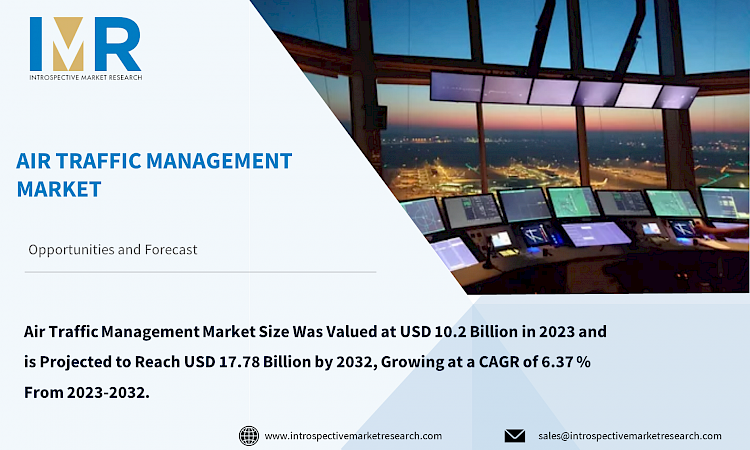Air Traffic Management Market
According to a new report published by Introspective Market Research, titled, “Air Traffic Management Market by Application, By Airspace and By End-User: Global Opportunity Analysis and Industry Forecast, 2024–2032,”
the Air Traffic Management Market Size Was Valued at USD 10.2 Billion in 2023 and is Projected to Reach USD 17.78 Billion by 2032, Growing at a CAGR of 6.37 % From 2023-2032.
The air traffic management (ATM) market includes systems, procedures, and services designed to ensure the safe and efficient movement of aircraft through airspace and airports. This includes a range of technologies such as radar, satellite navigation systems, communication systems, and automation systems used by air traffic controllers (ATC) to manage air traffic flows, avoid collisions, and optimize airspace capacity.
The ATM market has software solutions for flight planning, weather monitoring, and data analysis to improve operational efficiency and safety. As air traffic continues to grow worldwide, driven by increasing passenger demand and expanding fleets, the ATM market plays an important role in facilitating smooth and safe air travel. The hybrid electric vehicle market has gained a lot of popularity in recent years, e.g. global environmental factors, rising fuel prices, and global changes aimed at limiting the use of high-emission vehicles. Hybrid electric vehicles, or HEV in general, are vehicles that run on an internal combustion engine that works together with an electric motor and battery to provide better fuel economy compared to traditional low CO2 gasoline cars.
According to the global Air Traffic Management Market analysis, the market is divided by application, packaging type, material and geographical division. By application, it comprises personal care packaging, health care packaging, food & beverage packaging, and others. By packaging type, it includes recycled content packaging, reusable packaging, and degradable packaging. Based on the material, the market is segmented into plastic, metal, glass and others. By geography, it includes North America, Europe, Asia-Pacific, and LAMEA markets. Further, the report also covers the strategies adopted by key market players in order to sustain competitive environment and increase their market share.
The increase in the use of low-emission vehicles rather as a transitional technology to environmentally-friendly electric cars and light trucks is a turning point in the evolution of the automotive market towards sustainable and green technology. Hybrid electric vehicles or HEVs are the bridge between traditional ICE cars and future electric car technology, providing consumers with a reliable and sustainable transition to electric car acceptance. The reason is that many companies are more and more aware of the many environmental problems and the effects of burning fossil fuels and emitting greenhouse gases. At least one notable feature of hybrid cars is their ability to provide better fuel economy and lower pollution levels than conventional gasoline vehicles. The combination of electric motors and batteries and internal combustion engines in HEV vehicles ensures the efficiency of power transmission and the energy collected by regenerative brakes at the best level, so that fuel consumption is as low as possible, while the effect is carefully monitored.
The increased awareness of customers and governments about sustainability and increased caution about environmental impacts has also increased the use of green cars, which has encouraged the development of hybrid electric vehicles. With the threat of climate change looming and urban air quality dropping to new lows, the need for technological advances to solve the problems caused by conventional cars is paramount. In this context, HEV seems like a sensible middle ground between traditional gasoline cars and electric cars, which have become synonymous with environmental friendliness. Such affordability depends on their flexible fuel, which alternates between electricity and gasoline, reducing emissions and fuel dependency. Due to growing environmental concerns, when choosing a car, consumers tend to look for the technology behind an HEV to reflect their values.
Global Air Traffic Management Market, Segmentation
The Air Traffic Management Market is segmented based on Application, By Airspace and By End-User, and region.
Application:
The Application segment is further classified into Communication, Navigation, Surveillance, and Automation. Among these, the Communication sub-segment accounted for the highest market share in 2023. Communication is at the heart of effective air traffic management and acts as the life force that connects air traffic controllers, pilots and ground crews in a dynamic and safety critical environment. In the aviation industry, where split second decisions can make all the difference, effective communication systems are not only attainable, but essential. Traditional voice communication systems have long been a mainstay of air traffic control, facilitating clear and concise communication between air traffic controllers and pilots. However, with the help of digital technology, the aviation communication landscape is rapidly evolving. Communication mechanisms such as Controller-Pilot Data Link (CPDLC) and Automatic Dependent Surveillance Agreement (ADS-C) increasingly complement voice communications, enabling more efficient transmission of instructions, briefings and flight information between ground stations and aircraft.
End-User:
The application segment is further classified into Commercial and Military. Among these, the Military sub-segment is anticipated to show the fastest growth by 2032. Military aviation operations operate in a particular area characterized by specific mission objectives, different operational environments and higher security requirements. Unlike civil air traffic control, which focuses primarily on facilitating commercial and private aviation, military ATM solutions are tailored to meet the unique needs and challenges of armed forces worldwide. One critical component of military segment dominance is military airspace management, which involves the allocation, coordination, and control of airspace resources in support of military training, exercises, and operational missions. This often requires the establishment of restricted or controlled airspace zones to protect sensitive military installations, conduct training activities, or facilitate aircraft movements, ensuring minimal disruption to civil air traffic and compliance with international airspace regulations.
Region:
The Air Traffic Management Market in Asia-Pacific is projected to show the fastest growth by 2032. In the Asia-Pacific region, EV manufacturers are finding favorable ground for growth, driven mainly by the dominant car markets of Japan, China and South Korea. Not only do these countries have significant manufacturing capacity, but consumer demand for environmentally friendly transportation solutions is also high. China stands out as a global automotive powerhouse and has claimed the title of the world's largest car market. Government-led initiatives to combat air pollution and reduce dependence on fossil fuels have contributed to significant growth in the EV sector. By introducing strict emission standards and offering generous incentives such as subsidies and tax breaks, the Chinese government has effectively increased consumer interest in hybrid vehicles.
Some of The Leading/Active Market Players Are-
- Northrop Grumman Corporation
- Honeywell International Inc.
- Thales Group
- L3 Harris Technologies Inc.
- Raytheon Company
- Intelcan Technosystems Inc.
- Global Eagle Entertainment Inc.
- Becker Avionics Inc.
- BAE Systems Plc.
- Sierra Nevada Corporation and Other Active Players
Key Industry Developments
- In January 2024: Easy Jet announced that they are the first airline partner of the Iris program, which is an initiative led by the European Space Agency (ESA) as well as the global communications company Viasat. Both of these organizations are now making use of the latest generation of satellite technologies to help modernize air traffic management.
- In October 2023: Airport officials at Biju Patnaik International Airport located in Bhubaneswar, Odisha, announced that the airport received a new air traffic management automation system at the newly developed air traffic control center, which will help to improve the operational efficiency of the flight operations at the airport.
Key Findings of the Study
- The ATM market was valued at USD 10.2 billion in 2023 and is projected to reach USD 17.78 billion by 2032, growing at a CAGR of 6.37% during the forecast period (2023-2032).
- The market is segmented based on application (Communication, Navigation, Surveillance, Automation), airspace (Commercial, Military), and region (North America, Europe, Asia-Pacific, LAMEA). Communication systems accounted for the highest market share in 2023, reflecting their critical role in air traffic management.
- The market is witnessing rapid technological advancements, with digital communication systems like Controller-Pilot Data Link (CPDLC) and Automatic Dependent Surveillance Agreement (ADS-C) complementing traditional voice communication, enhancing efficiency and safety in air traffic control.
- Asia-Pacific is expected to show the fastest growth by 2032, driven by the dominant car markets in countries like Japan, China, and South Korea. Government initiatives promoting environmentally friendly transportation solutions, including hybrid electric vehicles, are contributing significantly to market expansion in this region.







